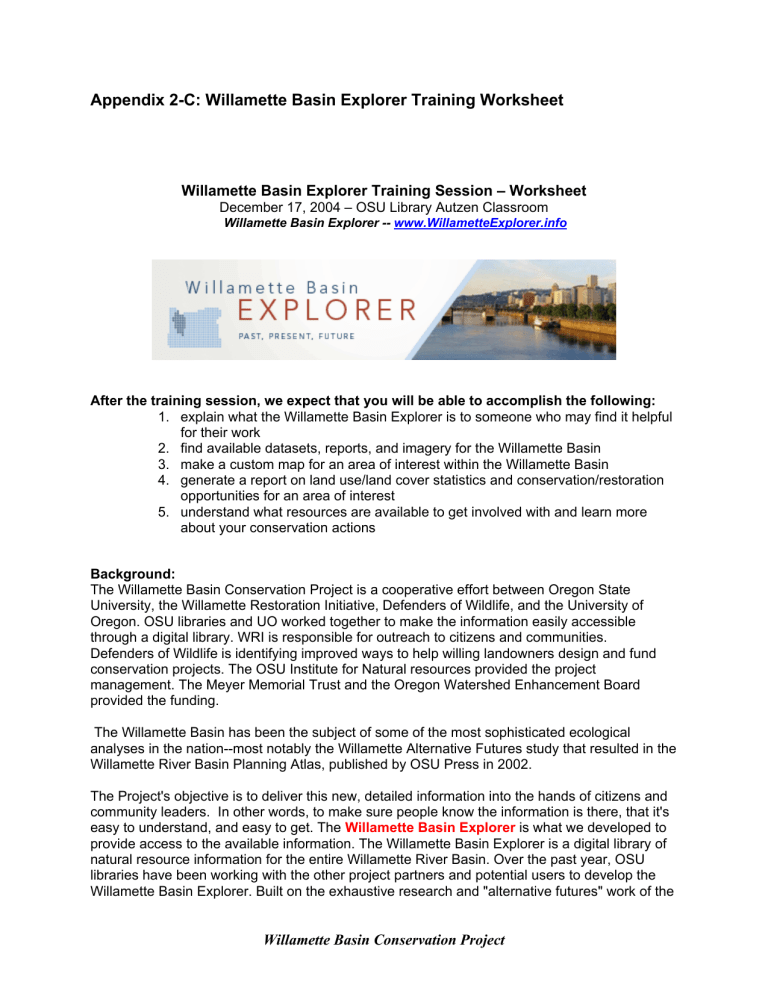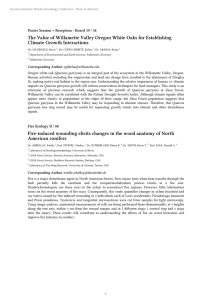Appendix 2-C: Willamette Basin Explorer Training Worksheet

Appendix 2-C: Willamette Basin Explorer Training Worksheet
Willamette Basin Explorer Training Session – Worksheet
December 17, 2004 – OSU Library Autzen Classroom
Willamette Basin Explorer -- www.WillametteExplorer.info
After the training session, we expect that you will be able to accomplish the following:
1. explain what the Willamette Basin Explorer is to someone who may find it helpful for their work
2. find available datasets, reports, and imagery for the Willamette Basin
3. make a custom map for an area of interest within the Willamette Basin
4. generate a report on land use/land cover statistics and conservation/restoration opportunities for an area of interest
5. understand what resources are available to get involved with and learn more about your conservation actions
Background:
The Willamette Basin Conservation Project is a cooperative effort between Oregon State
University, the Willamette Restoration Initiative, Defenders of Wildlife, and the University of
Oregon. OSU libraries and UO worked together to make the information easily accessible through a digital library. WRI is responsible for outreach to citizens and communities.
Defenders of Wildlife is identifying improved ways to help willing landowners design and fund conservation projects. The OSU Institute for Natural resources provided the project management. The Meyer Memorial Trust and the Oregon Watershed Enhancement Board provided the funding.
The Willamette Basin has been the subject of some of the most sophisticated ecological analyses in the nation--most notably the Willamette Alternative Futures study that resulted in the
Willamette River Basin Planning Atlas, published by OSU Press in 2002.
The Project's objective is to deliver this new, detailed information into the hands of citizens and community leaders. In other words, to make sure people know the information is there, that it's easy to understand, and easy to get. The Willamette Basin Explorer is what we developed to provide access to the available information. The Willamette Basin Explorer is a digital library of natural resource information for the entire Willamette River Basin. Over the past year, OSU libraries have been working with the other project partners and potential users to develop the
Willamette Basin Explorer. Built on the exhaustive research and "alternative futures" work of the
Willamette Basin Conservation Project
Pacific Northwest Ecosystem Research Consortium (the people who created the Willamette
River Basin Planning Atlas), this new digital library provides access to a much broader and ever-expanding collection of recent research, successful projects and general wisdom. We want this to be your best source for Willamette Basin landscape history, mapped data, planning guidance, conservation stories, photos, natural resource documents and reports, and links --- a rich collection of useful information to inform our collective efforts to improve the place we live.
The home page:
1. Learning about the Willamette Story: probably the most popular feature of the digital library is learning about the Willamette Basin’s past, present and future through an inviting narrative that combines text, audio, and pictures. Be sure to look at the video that flys you through a part of the river basin from Eugene to Corvallis.
Willamette Basin Explorer home page
About this site
Willamette stories
Critical issues
Photos and videos
2. Navigation : the Willamette Explorer has been designed to provide easy access to data, documents, photos, people resources, critical issues, etc.
1
Text highlighted in bold red are the actual names of the Willamette Basin Explorer buttons
Willamette Basin Conservation Project
Using the search box
Using the data button – geospatial data collections
Reviewing the metadata
Finding photographs – photos and videos
Accessing reports, documents, articles – publications
Knowing who to contact if you have a question or idea – people and expertise
3. Making a map : the two mapping tools are a main feature of the Willamette Basin Explorer.
The mapping tools are accessible from the mapping and reporting tools button on the home page. The mapping tools have been designed to help you create GIS applications and online maps for the Willamette Basin, as well as smaller areas within the basin.
Two views of the mapping tool will be demonstrated to accommodate the needs of novices and experts alike. For the novice, using the mapping tool wizard requires three easy steps. First, select what to map. We have made a selection of pre-built maps relating to the key issues of the
Willamette River Basin. Second, choose where you want the map centered. You can enter an address, a place name like a city or town name, or you can select a region like a county or a watershed. Once you have selected what and where to map, you get a “live” map. With the
“live” map, you can zoom in and out, turn on and off map layers, and identify map features. You can also print or email your map.
Willamette Basin Conservation Project
Use the Advanced map tool if you are familiar with basic GIS mapping techniques. You will be able to create maps using all available data layers and make use of the advanced tool set.
Willamette Basin Conservation Project
overlay of restoration projects and 1990 demographics
4. Generating a report: the newest addition to the Willamette Basin Explorer is the reporting tool. The reporting tool is accessible from the Map and report tools button on the home page.
With the reporting tool you can generate a report on land use/land cover statistics and conservation/restoration opportunities for an area of interest, between two areas of interest, or for the entire basin.
5. Getting involved: the Actions and Assistance button on the home page provides links to a list of agencies that can provide landowners and the interested citizens with information about natural resources regulations in the Willamette Basin and permits that are needed before moving ahead with conservation or restoration projects. Guidance on upslope, riparian and wetland, and in-channel stream restoration are also provided.
Willamette Basin Conservation Project
Name and affiliation:__________________________________________________________
Willamette Explorer Feedback: Your general thoughts
1. The Willamette Explorer will be useful for purposes of (check all that apply): a. Planning ___ c. Policy evaluation and development ___ d. Conservation and restoration activities ___
2. Did the site have the information you were expecting to find? ________________________
_________________________________________________________________________
_________________________________________________________________________
_________________________________________________________________________
3. Are there specific GIS data layers or other information sources we should consider adding?
Source: ________________________________________________________
Source: ________________________________________________________
Source: ________________________________________________________
4. Are there other statistical reports we should consider adding? f. Statistic:_____________________________________________________
Source: _____________________________________________________ g. Statistic:_____________________________________________________
Source: _____________________________________________________ h. Statistic:_____________________________________________________
Source: _____________________________________________________
5. Are there additional information or digital library features you would like to access?
_________________________________________________________________________
_________________________________________________________________________
_________________________________________________________________________
_________________________________________________________________________
_________________________________________________________________________
6. What Willamette Basin Explorer feature do you think will be the most useful for your work?
____________________________________________________________________________
____________________________________________________________________________
____________________________________________________________________________
Willamette Basin Conservation Project








